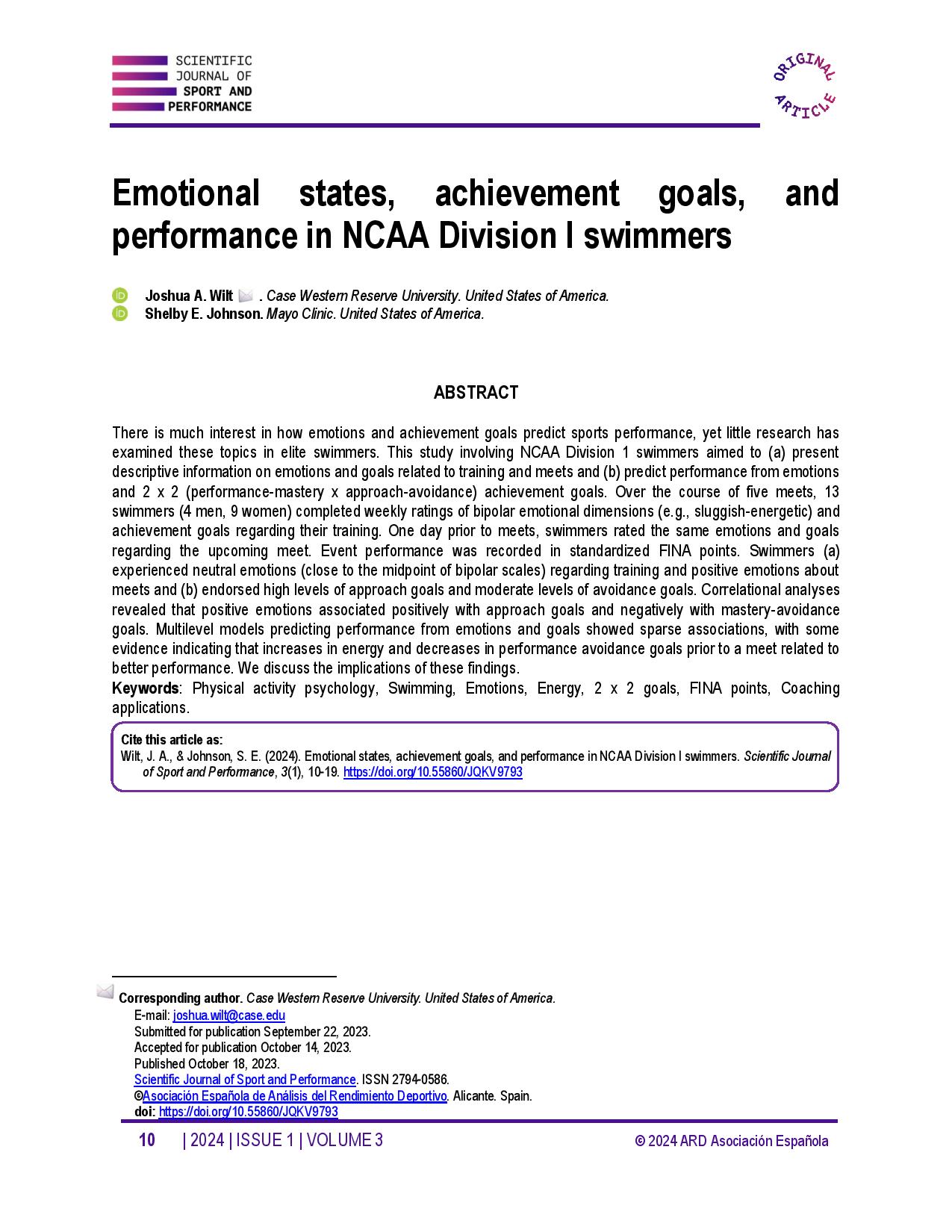Emotional states, achievement goals, and performance in NCAA Division I swimmers
Main Article Content
Abstract
There is much interest in how emotions and achievement goals predict sports performance, yet little research has examined these topics in elite swimmers. This study involving NCAA Division 1 swimmers aimed to (a) present descriptive information on emotions and goals related to training and meets and (b) predict performance from emotions and 2 x 2 (performance-mastery x approach-avoidance) achievement goals. Over the course of five meets, 13 swimmers (4 men, 9 women) completed weekly ratings of bipolar emotional dimensions (e.g., sluggish-energetic) and achievement goals regarding their training. One day prior to meets, swimmers rated the same emotions and goals regarding the upcoming meet. Event performance was recorded in standardized FINA points. Swimmers (a) experienced neutral emotions (close to the midpoint of bipolar scales) regarding training and positive emotions about meets and (b) endorsed high levels of approach goals and moderate levels of avoidance goals. Correlational analyses revealed that positive emotions associated positively with approach goals and negatively with mastery-avoidance goals. Multilevel models predicting performance from emotions and goals showed sparse associations, with some evidence indicating that increases in energy and decreases in performance avoidance goals prior to a meet related to better performance. We discuss the implications of these findings.
Article Details

This work is licensed under a Creative Commons Attribution-NonCommercial-ShareAlike 4.0 International License.
References
Bates, D., Mächler, M., Bolker, B., & Walker, S. (2015). Fitting linear mixed-effects models using lme4. Journal of Statistical Software, 67, 1-48. https://doi.org/10.18637/jss.v067.i01 DOI: https://doi.org/10.18637/jss.v067.i01
Beedie, C. J., Terry, P. C., & Lane, A. M. (2000). The profile of mood states and athletic performance: Two meta-analyses. Journal of Applied Sport Psychology, 12(1), Routledge--68. https://doi.org/10.1080/10413200008404213 DOI: https://doi.org/10.1080/10413200008404213
Burton, D. (1988). Do anxious swimmers swim slower? Reexamining the elusive anxiety-performance relationship. Journal of Sport & Exercise Psychology, 10(1), 45-61. https://doi.org/10.1123/jsep.10.1.45 DOI: https://doi.org/10.1123/jsep.10.1.45
Burton, D. (1989). Winning isn't everything: Examining the impact of performance goals on collegiate swimmers' cognitions and performance. The Sport Psychologist, 3(2), 105-132. https://doi.org/10.1123/tsp.3.2.105 DOI: https://doi.org/10.1123/tsp.3.2.105
Conroy, D., & Hyde, A. (2011). Measurement of achievement motivation processes. In G. Tenenbaum, R. Eklund, & A. Kamata (Eds.), Handbook of measurement in sport and exercise psychology (pp. 303-317). Human Kinetics. https://doi.org/10.5040/9781492596332.ch-027 DOI: https://doi.org/10.5040/9781492596332.ch-027
Conroy, D. E., Elliot, A. J., & Hofer, S. M. (2003). A 2 x 2 Achievement Goals Questionnaire for Sport: Evidence for factorial invariance, temporal stability, and external validity. Journal of Sport & Exercise Psychology, 25(4), 456-476. https://doi.org/10.1123/jsep.25.4.456 DOI: https://doi.org/10.1123/jsep.25.4.456
Craft, L. L., Magyar, T. M., Becker, B. J., & Feltz, D. L. (2003). The relationship between the Competitive State Anxiety Inventory-2 and sport performance: A meta-analysis. Journal of Sport and Exercise Psychology, 25(1), Human Kinetics Publishers-65. https://doi.org/10.1123/jsep.25.1.44 DOI: https://doi.org/10.1123/jsep.25.1.44
Elliot, A. J., & Church, M. A. (1997). A hierarchical model of approach and avoidance achievement motivation. Journal of Personality and Social Psychology, 72(1), 218-232. https://doi.org/10.1037/0022-3514.72.1.218 DOI: https://doi.org/10.1037/0022-3514.72.1.218
Elliot, A. J., & Thrash, T. M. (2002). Approach-avoidance motivation in personality: Approach-avoidance temperaments and goals. Journal of Personality and Social Psychology, 82, 804-818. https://doi.org/10.1037/0022-3514.82.5.804 DOI: https://doi.org/10.1037/0022-3514.82.5.804
Goetz, T., Sticca, F., Pekrun, R., Murayama, K., & Elliot, A. J. (2016). Intraindividual relations between achievement goals and discrete achievement emotions: An experience sampling approach. Learning and Instruction, 41, 115-125. https://doi.org/10.1016/j.learninstruc.2015.10.007 DOI: https://doi.org/10.1016/j.learninstruc.2015.10.007
Hanin, Y. L. (2000). Successful and poor performance and emotions. In Y. L. Hanin (Ed.), Human Kinetics (pp. 157-187). https://doi.org/10.5040/9781492596233.ch-007 DOI: https://doi.org/10.5040/9781492596233.ch-007
Hox, J., & McNeish, D. (2020). Small samples in multilevel modeling. Small sample size solutions, 215-225. https://doi.org/10.4324/9780429273872-18 DOI: https://doi.org/10.4324/9780429273872-18
Kavussanu, M., Dewar, A. J., & Boardley, I. D. (2014). Achievement goals and emotions in athletes: The mediating role of challenge and threat appraisals. Motivation and Emotion, 38(4), 589-599. https://doi.org/10.1007/s11031-014-9409-2 DOI: https://doi.org/10.1007/s11031-014-9409-2
Lane, A. M., Devonport, T. J., Soos, I., Karsai, I., Leibinger, E., & Hamar, P. (2010). Emotional intelligence and emotions associated with optimal and dysfunctional athletic performance. Journal of Sports Science & Medicine, 9(3), Hakan Gur, Journal of Sports Science & Medicine-392.
Lochbaum, M., & Gottardy, J. (2015). A meta-analytic review of the approach-avoidance achievement goals and performance relationships in the sport psychology literature. Journal of Sport and Health Science, 4(2), 164-173. https://doi.org/10.1016/j.jshs.2013.12.004 DOI: https://doi.org/10.1016/j.jshs.2013.12.004
McNeish, D. M., & Stapleton, L. M. (2016). The effect of small sample size on two-level model estimates: A review and illustration. Educational Psychology Review, 28, 295-314. https://doi.org/10.1007/s10648-014-9287-x DOI: https://doi.org/10.1007/s10648-014-9287-x
National Sporting Goods Association. (2020). Sports participation survey.
Nicholls, A. R., Polman, R. C. J., & Levy, A. R. (2012). A path analysis of stress appraisals, emotions, coping, and performance satisfaction among athletes. Psychology of Sport and Exercise, 13(3), 263-270. https://doi.org/10.1016/j.psychsport.2011.12.003 DOI: https://doi.org/10.1016/j.psychsport.2011.12.003
R Core Team. (2023). R: A language and environment for statistical computing. In R Foundation for Statistical Computing. Retrieved from: http://www.R-project.org [Accesed 10/14/2023].
Revelle, W. (2022). psych: Procedures for Personality and Psychological Research. Retrieved from: https://cran.r-project.org/web/packages/psych/ [Accesed 10/14/2023].
Russell, J. A. (1980). A circumplex model of affect. Journal of Personality and Social Psychology, 39(6), 1161-1178. https://doi.org/10.1037/h0077714 DOI: https://doi.org/10.1037/h0077714
Sorrentino, R. M., & Sheppard, B. H. (1978). Effects of affiliation-related motives on swimmers in individual versus group competition: A field experiment. Journal of Personality and Social Psychology, 36(7), 704-714. https://doi.org/10.1037/0022-3514.36.7.704 DOI: https://doi.org/10.1037/0022-3514.36.7.704
Thayer, R. E. (1978). Toward a psychological theory of multidimensional activation (arousal). Motivation and Emotion, 2(1), 1-34. https://doi.org/10.1007/BF00992729 DOI: https://doi.org/10.1007/BF00992729
Van Yperen, N. W., Blaga, M., & Postmes, T. (2014). A meta-analysis of self-reported achievement goals and nonself-report performance across three achievement domains (work, sports, and education). PLOS ONE, 9(4), e93594. https://doi.org/10.1371/journal.pone.0093594 DOI: https://doi.org/10.1371/journal.pone.0093594
Woodman, T., & Hardy, L. (2003). The relative impact of cognitive anxiety and self-confidence upon sport performance: A meta-analysis. Journal of Sports Sciences, 21(6), 443-457. https://doi.org/10.1080/0264041031000101809 DOI: https://doi.org/10.1080/0264041031000101809




